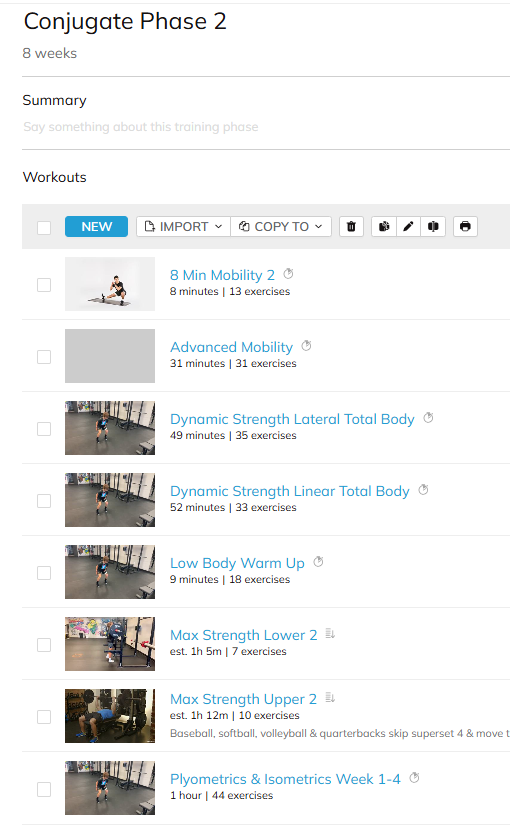Building a Well-Rounded Athlete Through Strategic Lower Body Training (Part 4 of 4)

Elite Edge Deep Dive: Integrating Lower Body Max Strength into the HSE Conjugate System (Part 4 of 4)
Building a Well-Rounded Athlete Through Strategic Lower Body Training
Bringing It All Together: The Role of Lower Body Max Strength in the HSE Conjugate System
Over the past three parts of our series, we’ve dived deep into the critical components of our Max Effort Lower Body Training:

- Part 1: An overview of the methodology—focusing on max effort lifts, contrast training, PAP, force coupling, and elastic energy utilization.
- Part 2: The importance of building a powerful posterior chain—targeting the glutes, hamstrings, and spinal erectors to enhance sprinting, jumping, and overall force production.
- Part 3: Developing lateral strength and speed—focusing on side lunges and lateral plyometrics to improve cutting, agility, and injury prevention.
In Part 4, we integrate these elements into the broader HSE Conjugate System for Youth Athletes, demonstrating how our lower body max strength session fits into our comprehensive training philosophy.

The HSE Conjugate System for Youth Athletes: A Holistic Approach to Athletic Development
The HSE Conjugate System for Youth Athletes is a multi-faceted training methodology designed to develop every aspect of athletic performance. While our Max Effort Lower Body Sessions are critical for building absolute strength, explosive power, and dynamic stability, they are just one part of a larger program that includes:
- Upper Body Max Strength Sessions: Focused on building pressing and pulling power, joint stability, and shoulder durability.
- Dynamic Effort Days: Emphasizing speed, acceleration, and reactive strength across both upper and lower body movements.
- Accessory and Mobility Work: Ensuring that movement quality is maintained, imbalances are corrected, and injury risk is minimized.
Our system is grounded in scientific principles such as Post-Activation Potentiation (PAP), Contrast Training, Force Coupling, and Elastic Energy Utilization. These concepts, drawn from established Strength & Conditioning research and adapted from elite methodologies like the Westside Barbell system, are customized for the needs of youth athletes. This ensures that each training session drives specific adaptations, which over time translate into higher performance on the field, court, or track.
The Importance of Individualization and Progressive Overload
A hallmark of the HSE Conjugate System is its individualized approach. Every athlete is different, and while the methodology is constant, the weights, progression, and accessory work must be tailored to the individual’s current capacity. This is why we emphasize training with a reps-in-reserve (RIR) method—allowing athletes to train intensely on days they have peak energy while avoiding overtraining on less optimal days. The 8-10 week phase of our Lower Body Max Strength session is designed to:
- Continuously challenge the neuromuscular system: Rotating squat and deadlift variations prevent adaptation plateaus.
- Optimize recovery: Structured rest intervals and accessory rotations reduce the risk of injury.
- Develop sport-specific power: Every movement is chosen to translate directly into improved performance—whether it’s faster sprint starts, higher vertical jumps, or sharper cutting ability.
Why Lower Body Max Strength is a Critical Piece of the Puzzle
The lower body is the engine of athletic performance. When executed correctly, these sessions provide athletes with:
✔ Enhanced Force Production: By recruiting high-threshold motor units, heavy lifts drive maximal strength gains.
✔ Improved Explosive Ability: Contrast training and plyometrics convert strength into power, ensuring that athletes can accelerate and decelerate rapidly.
✔ Balanced Movement Patterns: Unilateral and lateral training work ensure that no muscle group is neglected, reducing injury risk and increasing overall stability.
However, it’s essential to remember that no single session can make an athlete truly elite. The Lower Body Max Strength Day is one vital component of our training system—it works in concert with other sessions to create a well-rounded athlete who is strong, fast, and resilient.
Looking Ahead: Transitioning to Upper Body Max Strength

As we conclude our deep dive into the Lower Body Max Strength sessions, remember that this is just one part of a comprehensive training strategy. Our HSE Conjugate System for Youth Athletes is designed to integrate multiple training sessions, each targeting different aspects of athletic performance.
In our upcoming series on Upper Body Max Strength, we’ll break down the training logic behind developing pressing and pulling power, and show you how these sessions complement the lower body work to create a balanced, injury-resistant, and high-performing athlete.
Final Takeaways
1️⃣ Lower Body Max Strength sessions build the foundation for explosive power and movement efficiency.
2️⃣ Key principles such as PAP, contrast training, and force coupling are central to our methodology.
3️⃣ Individualization and progressive overload ensure continuous improvement and reduce injury risk.
4️⃣ These sessions are one part of the HSE Conjugate System—integrated with upper body and dynamic training for a holistic athletic development program.
Build a Stronger Foundation. Dominate Your Sport. Join the Movement.
This concludes Part 4 of our Lower Body Max Strength series. Stay tuned as we transition into our next series on Upper Body Max Strength, where we’ll continue to break down the scientific principles and training methodologies that drive elite performance in youth athletes. Let’s keep pushing boundaries and building champions together. 🚀🔥

